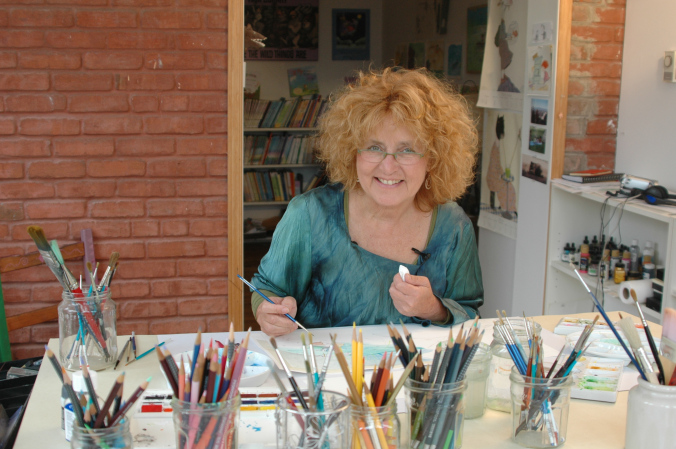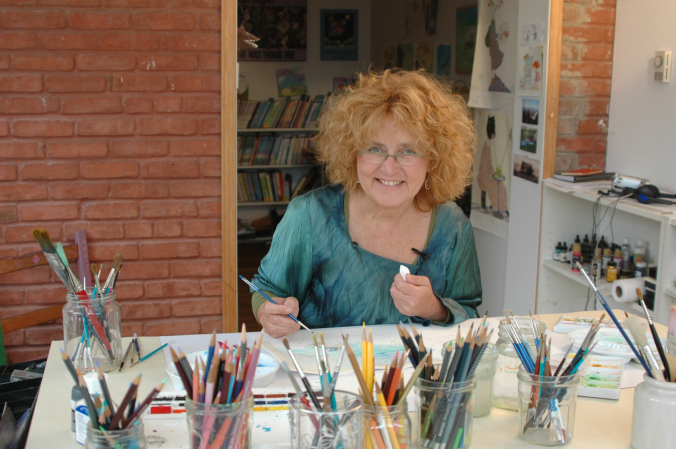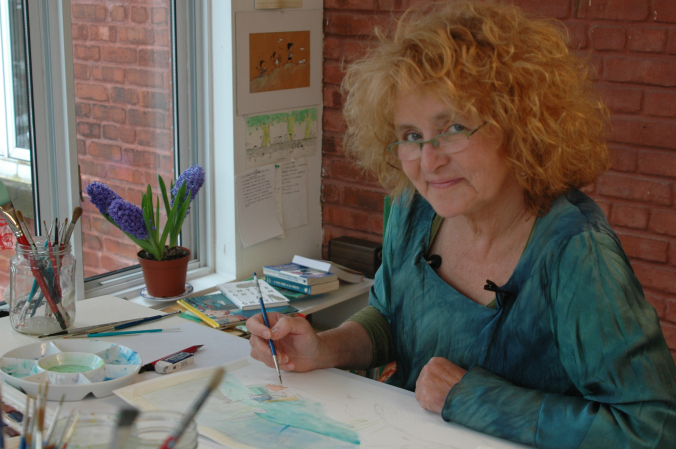A Tree Full of Stories (voir ci-dessous Un arbre qui raconte)
Last fall, I was approached by The Jewish Public Library of Montreal to create a permanent signage for their Children's Library. They wanted an image that would underline the importance of a children's library, entice children to enter and celebrate the joy of reading. The illustration would be enlarged and printed on three vertical banners and hung at the entrance to the Norman Berman Children's Library. I have often been invited to give many talks at this wonderful, pro-active, community-oriented library, from presenting at their huge Young Author's Conference to more intimate talks for their Mother-Daughter Book Club. I have always been impressed by the dedication and energy of the librarians who work there. I wanted to represent this energy with a dynamic, vibrant, colourful image. I also wanted it to be playful and humorous. Libraries are full to the brim with stories, so my illustration had to tell a story. I wanted children to stop and immerse themselves in my picture, "reading" it in the smallest details . . .
MLG JPL poster
(click on the image to see a larger version)
Did you notice the little grinning boy wearing a cape and plucking a star from the sky?
What about the boy who should be flying a kite but is actually "flying" a book opened to the "How to Build a Kite" page? Did you see Shelley the Turtle (a much loved resident of the Library), reading Shelley, A Turtle's Life? Or the young girl reading Romeo and Juliet just above a leaf that spells amour?
Books are full of words, so I also decided that I would draw words in the picture in English, French, Hebrew and Yiddish. (I must admit I did have to ask for help with the Hebrew and Yiddish.) I drew the illustration in pencil, painted in watercolour and working with handmade Japanese paper, cut out and painstakingly glued every one of the leaves!
I realize that this is exactly the way I work when I create the illustrations for my books: details and substories abound, every character and animal or object has a role . . .
I think this is the way very young children see the world. Everything has a story to tell.
Un arbre qui raconte...
L'automne dernier, la Bibliothèque publique juive m'a proposé de créer une illustration pour la Bibliothèque des enfants Norman Berman. Ils voulaient une image qui soulignerait l'importance d'une bibliothèque pour enfants, une image qui capterait immédiatement l'intérêt des enfants et qui célèbrerait la joie de lire. Cette illustration serait agrandie et imprimée sur trois bannières verticales et serait placée à l'entrée de la bibliothèque.
Au fil des ans, j'ai souvent été invitée à lire et à faire de présentations dans cette merveilleuse bibliothèque très active et dynamique. J'ai donné des ateliers lors de leur Conférence pour jeunes auteurs ainsi que des présentations plus intimes au Club de lecture Mère-Fille. J'ai été impressionné par l'énergie et le dévouement des bibliothécaires qui y travaillent. J'ai voulu représenter cette énergie par une image colorée et vibrante. J'ai voulu que mon illustration soit drôle et fantaisiste. Les bibliothèques sont remplies d'histoires alors mon dessin devait raconter une histoire... ou plusieurs. Je voulais que les enfants plongent dans mon dessin et qu'ils le lisent dans ses plus petits détails.
Avez-vous remarqué le petit bonhomme souriant qui cueille une étoile du haut de l'arbre? Ou la jeune fille qui lit Romeo et Juliette perchée au-dessus d'une feuille où s'inscrit le mot 'amour'? La famille de lapins-lecteurs? Autant de petites histoires . . .
Les livres sont pleins de beaux mots, de mots étranges ou de mots qui piquent notre curiosité, j'ai donc décidé d'inscrire des mots sur les feuilles de l'arbre en anglais, français, hébreu et yiddish. Mon illustration a été crée à l'aquarelle et au crayon. En travaillant avec du papier japonais fait-main j'ai découpé et collé chaque feuille de cet immense arbre.
Des heures de travail.
En fait, je travaille de la même manière lorsque je crée les illustrations de mes livres. Elles débordent de détails et petites histoires complices des enfants. Chaque personnage, chaque animal, chaque objet ont un rôle. Tous racontent une histoire. Je crois que c'est ainsi que les enfants voient le monde. Qui sait?
Girl on cloud






